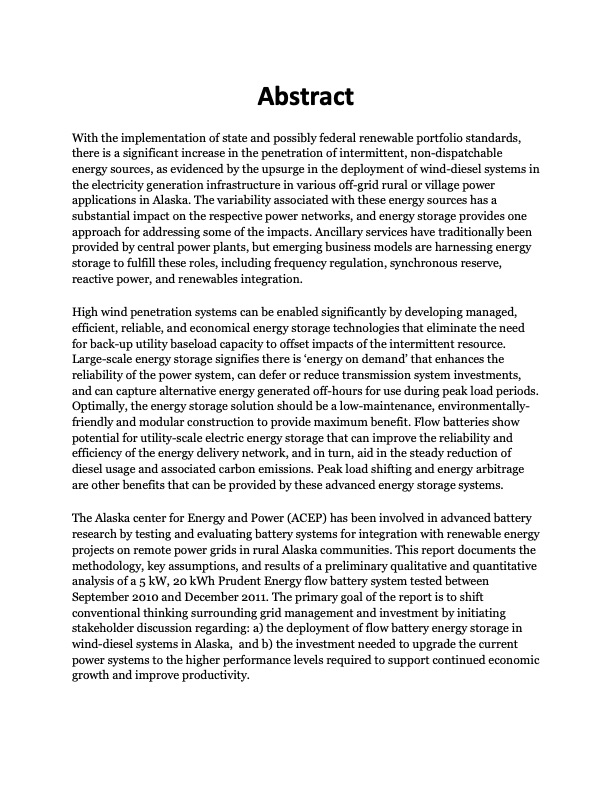
PDF Publication Title:
Text from PDF Page: 003
Abstract With the implementation of state and possibly federal renewable portfolio standards, there is a significant increase in the penetration of intermittent, non-dispatchable energy sources, as evidenced by the upsurge in the deployment of wind-diesel systems in the electricity generation infrastructure in various off-grid rural or village power applications in Alaska. The variability associated with these energy sources has a substantial impact on the respective power networks, and energy storage provides one approach for addressing some of the impacts. Ancillary services have traditionally been provided by central power plants, but emerging business models are harnessing energy storage to fulfill these roles, including frequency regulation, synchronous reserve, reactive power, and renewables integration. High wind penetration systems can be enabled significantly by developing managed, efficient, reliable, and economical energy storage technologies that eliminate the need for back-up utility baseload capacity to offset impacts of the intermittent resource. Large-scale energy storage signifies there is ‘energy on demand’ that enhances the reliability of the power system, can defer or reduce transmission system investments, and can capture alternative energy generated off-hours for use during peak load periods. Optimally, the energy storage solution should be a low-maintenance, environmentally- friendly and modular construction to provide maximum benefit. Flow batteries show potential for utility-scale electric energy storage that can improve the reliability and efficiency of the energy delivery network, and in turn, aid in the steady reduction of diesel usage and associated carbon emissions. Peak load shifting and energy arbitrage are other benefits that can be provided by these advanced energy storage systems. The Alaska center for Energy and Power (ACEP) has been involved in advanced battery research by testing and evaluating battery systems for integration with renewable energy projects on remote power grids in rural Alaska communities. This report documents the methodology, key assumptions, and results of a preliminary qualitative and quantitative analysis of a 5 kW, 20 kWh Prudent Energy flow battery system tested between September 2010 and December 2011. The primary goal of the report is to shift conventional thinking surrounding grid management and investment by initiating stakeholder discussion regarding: a) the deployment of flow battery energy storage in wind-diesel systems in Alaska, and b) the investment needed to upgrade the current power systems to the higher performance levels required to support continued economic growth and improve productivity.PDF Image | Advanced Battery Storage Systems Testing at ACEP VRB ESS

PDF Search Title:
Advanced Battery Storage Systems Testing at ACEP VRB ESSOriginal File Name Searched:
ACEP-VRB-Testing-Report.pdfDIY PDF Search: Google It | Yahoo | Bing
Salgenx Redox Flow Battery Technology: Salt water flow battery technology with low cost and great energy density that can be used for power storage and thermal storage. Let us de-risk your production using our license. Our aqueous flow battery is less cost than Tesla Megapack and available faster. Redox flow battery. No membrane needed like with Vanadium, or Bromine. Salgenx flow battery
| CONTACT TEL: 608-238-6001 Email: greg@salgenx.com | RSS | AMP |